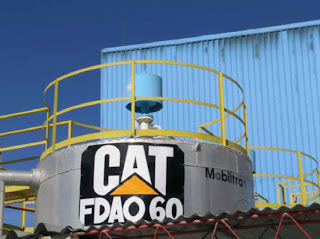Maximizing component life and minimizing component cost-per-hour requires that fluid cleanliness be maintained at very high levels. This requires a new approach to measuring and managing fluid cleanliness. Effective fluid management requires a process to:
- Identify when fluids are dirty
- Identify when fluids are clean
- Maintain records to show how the fluids are behaving over history
This site has created a process to measure machine fluid cleanliness (particle count) at each service, both when the machine enters for service and after the service is complete. All records are maintained in a central database with results trended for variation.
2.0 Best Practice Description
Measuring Fluid Cleanliness
All fluids on the mine site are regularly checked for cleanliness. This site uses the Pamas S-40 particle counter to take particle count measurements in all filtered machine compartments at each PM.
 |
| Pamas S-40 particle counter |
Data Entry
All particle-counting records are stored and analyzed in a Microsoft Access database, created by Unatrac. Data entry is simple and efficient.
Key fields include:
- Machine ID
- Sample ID
- Machine hours
- Date
- Particle count
Lube and Hyd oils: particles >6 & >14 um
Fuel: particles >4 / >16 / >14 um
 |
| Particle Count Data Screen Data entry is quick and convenient. |
Fluids Sampled
New Oils
Due to the remote location and lack of infrastructure, all hydraulic and lube oils are delivered to the site in 1,000 liter, disposable plastic cubes. Samples are taken from each cube and at the dispensing point and the cleanliness level recorded.
Many new oils have large amounts of additives, which tend to clump together in clusters, which are large enough to be recorded as particles when using a laser particle counter. This is known as “additive interference”. The combination of contamination from the new plastic container and the effects of additive interference often result in the new oil exceeding the cleanliness target of ISO 16/13 for new oil. Trying to achieve the new oil cleanliness target by kidney looping multiple grades of oil in dozens of cubes is impractical. New oil cleanliness is achieved during oil changes, by kidney looping the system, after the new oil is in the machine.
Fuel
Fuel is checked on a weekly to daily basis for compliance with the ISO 18/16/13 standard. Both, the dealership, and the fuel supplier take the measurements. Regular non-conformance is recorded in the case of future frequent fuel system problems.
Machine Fluids
On-machine fluids are checked for cleanliness at every PM service. The process followed is as follows:
1. The machine enters the PM bay and an oil sample is taken and particle counted for all major systems (example. 785C - hydraulic, steering, transmission, rear axle).
2. If the ISO reading is above 18/15, then the system is kidney loop filtered. If the particle count is 18/15 or better, then the system does not have to be kidney looped. (A flow chart of the process is shown on the following page).
3. Before the machine is returned to service, an additional oil sample is taken and particle count performed.
4. Both before PM service and after PM service particle count reading are recorded in the database.
5. SOS is also performed and these readings are matched with the particle count readings.
6. Measurements are tracked over time and particle counts are observed.
Decisions to change the PM service activities are strongly influenced by particle counts.
On new and rebuilt components, the break-in process generates additional debris, which results in higher particle counts. Systems that measure higher than ISO 18/15 at the end of the PM period are kidney looped to 16/13 during the PM to accelerate the removal of break-in debris. When the system can maintain ISO 18/15 or better at the end of the PM period, the onboard filters are maintaining system cleanliness and kidney looping can be discontinued.
A sudden and significant increase in particle count or premature filter plugging indicates abnormal component wear. This triggers an immediate SOS sample and inspection.
Machines in the fleet have been fitted with Ultra-High Efficiency (UHE) filters on powertrain and hydraulic systems. These filters are capable of maintaining high levels of fluid cleanliness once break-in debris has been removed. Kidney looping at each PM is discontinued after the onboard filtration demonstrates the ability to maintain ISO 18/15 or better through the PM period. This results in better PM efficiency.
The process map below illustrates this logic.
 |
| Measurement & Recordkeeping Process Map |
3.0 Implementation Steps
Fluid cleanliness measurement and recordkeeping is part of a larger fluid cleanliness management strategy in place at this site. A critical part of this strategy is to consistently measure and record particle counts.
This requires at least two portable particle counters on site. While great strides have been made in reliability and durability of portable particle counters, they are still lab instruments used in the field. Repair of these instruments requires they be shipped back to the manufacturer for several weeks. Back-up units must be available to continue to gather data on a daily basis.
4.0 Benefits
Effective measurement, recording and trending of particle count data provides a simple and powerful management tool to improve PM efficiency and identify abnormal wear or failure quickly.
5.0 Resources Required
Cost of a typical particle is approximately $10,000 USD. A minimum of two is required. The cost of training personnel to use the equipment, take samples and record data is minimal.
6.0 Supporting Attachments / References
Improving Component Durability – Fluid Cleanliness Management booklet
• This document explains additive interference, laser particle counting, fluid filter ratings, filter media, etc.
• Available in paper only. Caterpillar literature number: SEBF1020
7.0 Related Best Practices
0806-2.1-1000 Fluid Cleanliness Management
0806-2.1-1001 Measuring Oil Cleanliness
8.0 Acknowledgments
This Best Practice was written by:
Jeff Wolffe
CGM EAME Product Support
Wolffe_Jeffrey_S@cat.com
+41-22-849-4423
















